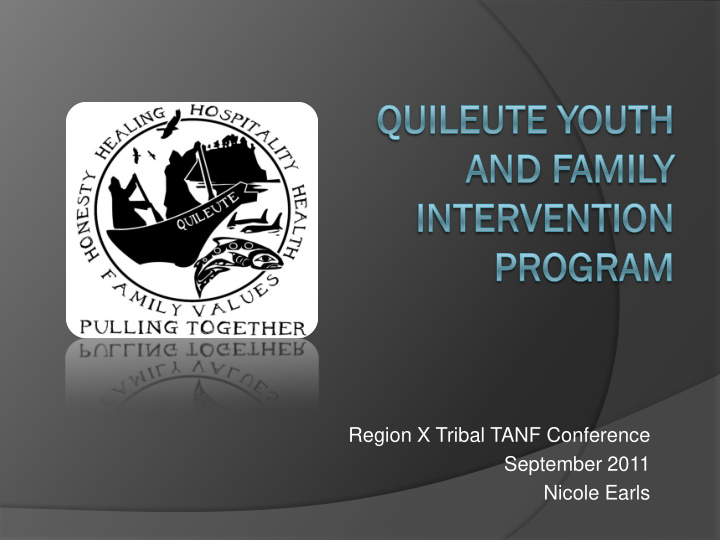



Region X Tribal TANF Conference September 2011 Nicole Earls
Nicole Earls, TANF Coordinator Tara Newman- Youth & Family Intervention Advocate Casey Keith- Youth & Family Intervention Advocate Brenda Freeman, Evaluator
Program VISION: We envision a community with: a low teen pregnancy rate where youth who have good decision-making skills are actively engaged in their culture, educational success, and career planning. a high capacity for effective parenting , where destructive multigenerational cycles are understood and where parent-child relationships are strong.
Overall Goals Family Stability Academic Success Self-Expectations for future goal achievement Dependence on TANF and ICW Generational Cycles of Poverty Teen Pregnancy Academic Failure
Program Goals To broaden perspectives of youth through 1. exposure to occupations, leadership training, and diverse cultures To develop in youth the skills to recognize 2. unhealthy life choices, and provide the tools and knowledge for healthy decision-making. To build parenting skills and better parent/child 3. relationships To increase the amount of time families engage in family activities which promote 4. healthy living and positive parent-child communication
From Goals to Program Activities… Broaden Perspectives of • Off-site Youth Trips Youth Develop Youth Decision-Making • Boys and Girls Groups Skills Build Parenting • Parenting Groups Skills Increase Family • Family Fun Night Engagement
Youth Trips Off Reservation Trips Muckleshoot Indian College– Muckleshoot Reservation Basket Weaving Conference– Quinault Northwest Indian College-- Lummi Reservation University of Washington– Seattle Gray’s Harbor Community College– Aberdeen Peninsula College, Port Angeles Bates Technical College– Tacoma Central Washington University, Heritage College and Prevention Summit Occupational Exploration: Hair Studio and Aglazing Art Studio- Port Angeles Olympic College- Bremerton Northwest School of Wooden Boatbuilding- Port Hadlock
Summary of Preliminary Evaluation Findings (Youth Trips) ○ Improvement of fidelity of ○ Shift in focus over the life of the trips over life of the program from fun to meaningful. program. ○ As the program developed, there ○ Reduction in neutral or was more careful discernment of negative comments after the impact of certain experiences: first three trips. prevention summit—expansion of world view; college trips—acquiring information and self-efficacy. ○ Length of the travel reports improved drastically—from three words to three pages. ○ Empowerment, Modeling, and Higher Self-Expectations are new themes which emerged in the data from the last three trips.
New and and Expect cting Mom’s L Luncheon • To reach women who were or are teen moms and are pregnant or have a child under 5 years old. ** • **Third purpose of TANF – Prevent and reduce the incidence of out-of-wedlock pregnancies
The Format: • By utilizing a combination of Youth and Family Intervention Program and TANF funds we are holding hour-long lunch events for local teen moms. • The speaker presents on a topic offering helpful information, facts, and answers questions related to their field of expertise. • The lunch offered is a glimpse of healthy and tasty food. • Each of the moms takes home a gift package relating to the topic of the day.
Participation in Mom’s Groups: 2009 to 2010 Average Number of Participants Per Session 16 14 12 10 8 6 4 2 0 2009 2010 Average Number of Participants
Success Factors 96% Positive Consumer Satisfaction (They liked it!) Positive Interactions Quality Between Curriculum Participants or Materials Excellent Facilitation Relevant Topics Good Speakers
Family Activities (Family Fun Night) Only 28.6% (post-test) Most families are quite engaged hold family meetings , together , with over 50% of the though most of the participants engaging in half of the participants have activities listed. children under 18 living Results for pre- post- changes in in the home. We hope level of activity are inconclusive for future improvements. (increased percentages in 7 activities; decreased percentages in 10 activities); changes could be due to economic factors, time of year of testing, instrumentation factors, retrospective nature of questions, or improvements in the quality of the data collection procedures . Work on sustainability—how do we help families sustain healthy family functioning?
About the future…
Recommend
More recommend